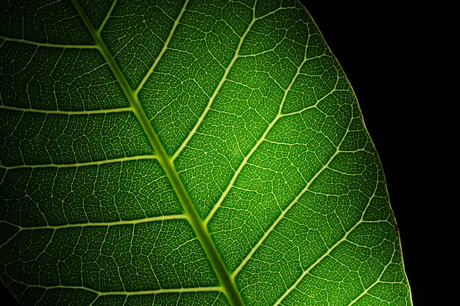Leaf-inspired micro-supercapacitor

Scientists have created a new micro-supercapacitor (MSC) that doesn’t have the shortcomings of previous attempts and delivers high electrochemical performance.
The scientists modelled their MSC film structure on natural vein-textured leaves in order to take advantage of the natural transport pathways which enable efficient ion diffusion parallel to the graphene planes found within them.
To create this final, efficient shape, the team layered a graphene-hybrid film with copper hydroxide nanowires. After many alternating layers, they achieved the desired thickness and added an acid solution to dissolve the nanowires so that a thin film with nano-impressions was all that remained.
To fabricate the MSCs, the film was applied to a plastic layer with thin, 5 μm-long parallel gold strips placed on top. Everything not covered by the gold strips was chemically etched away so that only the gold strips on top of a layer of film were left. Gold contact pads perpendicular to the gold strips were added and a conductive gel filled in the remaining spaces and was allowed to solidify. Once peeled from the plastic layer, the finished MSCs resembled clear tape with gold electrical leads on opposite sides.
The team of researchers, including scientists from the Center for Integrated Nanostructure Physics at the Institute for Basic Science (IBS) and Department of Energy Science at Sungkyunkwan University in South Korea, produced stunning test results. In addition to its superior energy density, the film is highly flexible and actually increases capacitance after initial use.
The volumetric energy density was 10 times higher than currently available commercial supercapacitors and also far superior to any other recent research. The MSCs are displaying electrical properties about five orders of magnitude higher than similar lithium batteries and are comparable to existing, larger supercapacitors.
“To our knowledge, the volumetric energy density and the maximum volumetric power density in our work are the highest values among all carbon-based solid-state MSCs reported to date,” said lead researcher Young Hee Lee.
In the future, consumers will likely power their devices with MSCs instead of batteries. The team’s MSCs could be embedded into an electronic circuit chip as power sources for practical applications such as implantable medical devices, active radio-frequency identification tags and microrobots. If engineers utilise the material’s incredible flexibility, these MSCs could be utilised in portable, stretchable and even wearable electronic devices.
Soft robot uses magnetic fields to power itself autonomously
Inspired by the movement of manta rays, researchers have developed a small, magnetically powered...
Perovskite 'energy sandwich' could power next-gen solar
Researchers have achieved a new level of control over the atomic structure of halide perovskites,...
Creating the truck of tomorrow
Exploring the technological innovations, infrastructure solutions and emerging delivery methods...





